- Dodge Super Bee
-
Dodge Super Bee 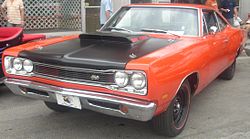 1969 Dodge Coronet Super Bee
1969 Dodge Coronet Super BeeManufacturer Chrysler Corporation (1968–1980)
DaimlerChrysler (2007)
Chrysler LLC (2008–09)Production 1968–1971
1970–1980 (Mexico only)
2007–2009Class Muscle car Layout FR layout The Dodge Super Bee was a limited-production muscle car from Dodge, produced from 1968-1971. The Super Bee model was resurrected for the 2007, 2008 and 2009 model Dodge Charger Super Bee.
Contents
1968–1970
First generation 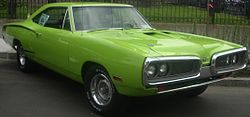
Production 1968–1970 Assembly Newark, Delaware, United States Platform B-body Engine 383 cu in (6.3 L) V8
426 cu in (7.0 L) V8
440 cu in (7.2 L) V8Transmission 4-speed manual
3-speed Torqueflite automaticWheelbase 117.0 in (2,972 mm) Related Dodge Coronet
Plymouth Satellite
Dodge Charger
Plymouth Road Runner
Plymouth GTX
Plymouth BelvedereThe original Super Bee was based on the Dodge Coronet. It was a two-door coupe model only and was produced from 1968 through 1970. It was the company's low-priced muscle car, cousin of the Plymouth Road Runner, and was priced at $3,027. The name "Super Bee" was derived from the "B" Body designation given Chrysler's midsized cars which included the Coronet (as well as the Roadrunner, Charger, etc.).
Plymouth Division had introduced the Road Runner first and the car sold well, prompting Dodge Division General Manager Robert McCurry to have the Dodge Styling office create a competitor. During that time, both divisions were competing to be the "Chrysler Performance Division". The designers were assigned the task of creating a name and identity for the Dodge version. Senior designer Harvey J. Winn won the "contest" with the name Super Bee and a new logo design around the Dodge "Scat Pack" Bee medallion. The first Super Bee was based on a 1968 Coronet convertible. The show car was built at Alexander Brothers Custom Shop under Winn's direction and was introduced at the 1968 Detroit Auto Show.
Although the two cars are very similar in external appearance, the Super Bee was slightly heavier (approx 65 lb (29 kg)) and rode on a 117-inch (3,000 mm) wheelbase compared to the Road Runner's 116 in (290 cm) wheelbase. In addition to the slight aesthetic external differences, such as larger rear wheel openings, the bumble bee tailstripe and fancier grille and taillight ornamentation, the Super Bee also used actual diecast chrome plated "Bee" medallions. These three-dimensional medallions were prominently mounted in a raised position in the grille/hood area and the trunklid/taillight area of the car throughout the first three years of production, and added a touch of class and panache.
The interior of the Super Bee borrowed the race car–inspired and more sophisticated gauge and speedometer dash cluster from the Dodge Charger while the four-speed manual cars received an actual Hurst Competition-Plus shifter with Hurst linkage, compared to the budget-minded Road Runner's less expensive Inland shifter and linkage. All these niceties added to the higher purchase price of the Super Bee compared to its Plymouth cousin, and ultimately affected its sales numbers over the years it was produced.
The Super Bee, like nearly all Chrysler muscle cars of that era, was available with the Hemi engine, however this option raised the price by 33% and only 125 were sold. The 1968 model only came as a two-door coupe, with two engine options, the base 335 hp (250 kW) 383 Magnum, and the 426 Hemi rated at 425 hp (317 kW).
The Super Bee included a heavy-duty suspension, an optional Mopar A-833 four-speed manual transmission, and high-performance tires. Outside, a stripe (with the bee logo) was wrapped around the tail.
A hardtop version joined the existing pillared coupe body for 1969, and a new optional twin-scooped air induction hood was now available and became known as the "Ramcharger". This particular option was coded N-96 and was the counterpart to the Plymouth Road Runner's "Coyote Duster" air induction hood. Of particular interest is that the Super Bee's "Ramcharger" hood featured forward-facing scoops which were far more efficient[citation needed] than the Road Runner's "twin vents" which merely lay flat on the hood, not forcing air in to the carburetor(s) as the Super Bee's did. Regardless of whether it was a Road Runner or Super Bee, the N-96 option commands immediate, extra respect whether it was at a stoplight or at the ever-present, modern day collector car auctions, as this option will drive up the selling price over a non N-96 equipped car.[citation needed]
A "six-pack" (three two-barrel carburetors) version of Dodge's 440 cubic inch engine was added to the offering list mid-year. This option fell half-way between the standard engine and the Hemi as a $463 option. The 1969 model year gave Chrysler customers several engines from which to choose — the base 383 hp (high performance), 440 Six Pack, and the 426 Hemi. The 440 Magnum (4bbl) was not an available option, and was reserved for the Coronet R/T.
For 1970, the Super Bee received a cosmetic redesign and was given a new front end that consisted of a twin-looped front bumper that Dodge Public Relations referred to as "bumble bee wings"[citation needed]. Because of or in spite of this new look, sales plummeted for the year from 15,506 in 1970 to 5,054 in 1971 (another sales pressure was higher insurance rates on performance cars; the similar Plymouth Road Runner and Plymouth Duster both experienced similar sales issues) [1]. Ironically this particular design change is what makes it the most popular year of the Super Bee to own today[citation needed]. Despite the new looks, the engine choices and the "ramcharger" hood carried over from 1969, the 1970 cars from Dodge were chock-full of new and improved options. For example, a "C- stripe" variant of the bumble stripe was offered, in addition to new high-back bucket seats, steering column-mounted ignition and a "pistol-grip" Hurst shifter on four-speed models.
Rumors abound of the many concept and show vehicles Chrysler produced during the muscle car era, including producing four concept Super Bee convertibles[citation needed]. The whereabouts of these four cars are unknown.
Engines:
- 1968–1970: 383 in³ (6.3 L) Big-Block V8, 335 hp (250 kW)
- 1968–1970: 426 in³ (7.0 L) Hemi V8, 425 hp (317 kW)
- 1969–1970: 440 in³ (7.2 L) Big-Block V8, 390 hp (291 kW)
Production:
- 1968: 7,842–7,717 (383), 125 (426 Hemi)
- 1969: 27,800–25,727 (383), 1,907 (440 Six Pack), 166 (426 Hemi)
- 1970: 15,506
1971
Second generation 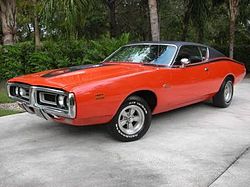
Production 1971 Assembly United States: Detroit, Michigan
Hamtramck, Michigan
Los Angeles, California
St. Louis, MissouriPlatform B-body Engine 340 cu in (5.6 L) V8
383 cu in (6.3 L) V8
426 cu in (7.0 L) V8
440 cu in (7.2 L) V8Transmission 4-speed manual
Torqueflite automaticRelated Dodge Coronet
Plymouth Satellite
Dodge Charger
Plymouth Road Runner
Plymouth GTXSince the 1971 Coronet was only available in sedan and station wagon versions, the Super Bee model was moved to the Charger platform. Since the Charger already had an R/T muscle car version, the Super Bee was slotted in as the low-priced entry in the line at US$3,271. 5,054 were produced which includes the 22 with the Hemi engine.
The moniker was discontinued until the 2007 Super Bee, which was a Charger SRT-8.
1971 was the first and only year that a small block engine (340 4-bbl) became available in the Super Bee.
Although the 440 Magnum (4-bbl) was not an available option on the Super Bee for 1971, 26 are known to have been built.
Engines:
- 1971: 340 in³ (5.6 L) Small-Block V8, 275 hp (205 kW)
- 1971: 383 in³ (6.3 L) Big-Block V8, 300 hp (224 kW)
- 1971: 440 in³ (7.2 L) Big-Block V8, 370 hp (275 kW)
- 1971: 440 in³ (7.2 L) Big-Block V8, 385 hp (287 kW)
- 1971: 426 in³ (7.0 L) Hemi V8, 425 hp (317 kW)
1970s Mexican Valiant Super Bee
First generation (Mexico) 
Production 1970–1976 Assembly Toluca, Mexico Predecessor Plymouth Barracuda Successor Dodge Magnum Class Sports Car Body style 2-door coupe Layout FR layout Platform A-body Engine 318 cu in (5.2 L) LA V8 (1970-1973)
360 cu in (5.9 L) LA V8 (1974-1976)Transmission 4-speed manual
3-speed TorqueFlite automaticRelated Dodge Dart
Plymouth Valiant
Plymouth DusterSecond generation (Mexico) 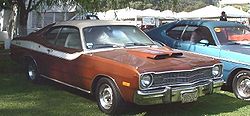
Production 1977–1980 Assembly Toluca, Mexico Body style 2-door coupe Platform F-body Engine 360 cu in (5.9 L) LA V8 Transmission 4-speed manual
3-speed TorqueFlite automaticWheelbase 108.7 in (2,761 mm) Length 198.8 in (5,050 mm) Width 73.3 in (1,862 mm) Height 53.3 in (1,354 mm) Related Dodge Aspen
Plymouth VolareIn 1970 Chrysler introduced the new generation of the Plymouth Barracuda and the new Dodge Challenger, but in Mexico these cars were too expensive in production and price for the market, so in 1970, Chrysler of México introduced the sport model Valiant Super Bee. Unlike the American Dodge Super Bee, the mexican version was based on the Chrysler A-Body platform. The Valiant Super Bee was a rebaged version of the Valiant Duster and the Dodge Dart. In Mexico officially never existed the Plymouth brand and Plymouth models were sold under the Dodge brand.
From 1970 to 1972 the Super Bee had the same front and rear of the Plymouth Duster and from 1973 to 1975 had the front of the Dodge Dart and the rear of the Plymouth Duster, in 1976 it back to the Valiant/Duster body. The Valiant Super Bee was equipped with the 318 V8 engine with 270 horse power from 1970 to 1974 and 1975 to 1976 with the 360 V8 engine with 300 horse power.This engines have more power in Mexico than in U.S.A. because mexican anti-pollution Laws were not as strict as in the US. As well as its cousins the Dodge Dart and Valiant Duster. With the years they only received minor changes as new grilles and rear panels and tail lights. This first generation was produced from 1970 to 1976. In 1976, Chrysler introduced the new F-Body cars: Dodge Aspen and Plymouth Volare, and the Aspen R/T and Volare Road Runner as its Sports versions.
Chrysler of México decided to continue with the old names one year later, so the twins Dodge Aspen/Plymouth Volare were sold in Mexico as the Dodge Dart and the Valiant Volare, and the sport version was named the Valiant Super Bee. The mexican Dodge Dart had the front of the US Plymouth Volare and the rear of the Dodge Aspen and the mexican Valiant Volare and the Dodge Super Bee had the front of the Dodge Aspen and the rear of the US Plymouth Volare.
The Super Bee was equipped with the 360 V8 engine and 300 horsepower,the 3-speed Torque Flite automatic transmission or the 4-speed manual transmission, sports wide wheels, front spoiler, rear spoiler style Trans Am with the Super Bee spelling, with a optional equipment could have a blind in the rear window. Super Bee was one fastest car in Mexican territory, overtaking cars like the Ford Mustang and even cars bigger than it like the Chevrolet Malibu. Even the federal highway patrol used Super Bee as squad car, and was a very efficient patrol, it was very difficult to find cars faster than the Super bee. For the 1980 model year,the Super Bee received a new front with rectangular headlamps.
For the 1981 model year, was introduced in Mexico the Dodge Diplomat, under the name of Dodge Dart, replacing the Dodge Aspen, and was considered a luxury car. A new sport version of the 1981 Dodge Dart replaces the Valiant Super Bee and now is called the Dodge Magnum, it had the 360 V8 engine and 270 horsepower, with variation in transmissions: The three speed automatic and the four-speed manual.
2007
Dodge Super Bee 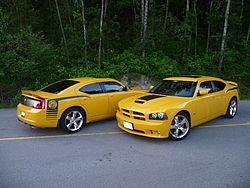
A new 2007 Super Bee model was introduced at the 2006 North American International Auto Show. This model is based on the Dodge Charger SRT-8 and uses special "Detonator Yellow" paint with flat black hood and fender decals. The production version vent to a hood decal instead of the entire hood being black, and the "hockey stick" stripe on the side was changed from solid black to dashed black stripe at the bottom. The wheels are fully polished instead of having silver painted areas like the stock SRT8 Charger. The interior is completely black with yellow accent stitching on the seats and shift knob, unlike the two tone interior of the standard SRT8 Charger with its red stitching. This Charger is the only model with this interior, as the Charger interior changed for 2008. The shifter bezel and centre console has a carbon fibre look, and the Super Bee logo appears in the instrument cluster at power up instead of the SRT logo. It is a limited edition car, with only 1000 built for model year 2007, with build dates as early as August 2006. Each car is built in Brampton Assembly Plant, then shipped to Windsor to have decals applied and unique number plaque applied to the passenger side of the dash. Number sequence on dash, does not necessarily follow build order, as multiple "Bees" were shipped to Windsor by car carrier and order was not retained. It uses the same 425 bhp (317 kW; 431 PS) HEMI 6.1 Liter engine as the SRT8 versions of the Dodge Charger, Dodge Magnum, Dodge Challenger and Chrysler 300C.
2008
For the 2008 model year, the Super Bee was only made in "B5 Blue Pearl Coat" (sometimes listed as "Surf Blue Pearl" [1] [2]), reminiscent of the blue used by Chrysler vehicles in the 1960s and 1970s. Instead of fully polished SRT8 Charger wheels, the "pockets" are painted black. Blue accent stitching inside replaces the yellow found on the seats and steering wheel, but the Charger's interior was changed for 2008, so the dash and console are different than the 2007 version interior. Again, it was based on the SRT-8 model and used the 6.1L engine, and had a limited production run of 1000.
2009
For the 2009 model year, the Super Bee was only made in "Hemi Orange Pearl Coat" [3], and was based on the SRT-8 model. The Super Bee used the 6.1L engine, and had a limited production run of only 425.
2012
In 2011, it was announced that the Super Bee will be returning as a 2012 model on the redesigned Dodge Charger with the 392 HEMI engine in "Stinger Yellow" and "Pitch Black" colors.[2]
References
Dodge Current
productionCarsTrucks (Ram)Discontinued Cars024 · 330 · 400 · 600 · 880 · Aries · Aspen · Avenger · Brisa · Challenger · Charger (B-body) · Charger (L-body) · Charger Daytona · Colt · Conquest · Coronet · Custom 880 · Dart · Daytona · Demon · Diplomat · Dynasty · Intrepid · La Femme · Lancer · Matador · Mirada · Monaco · Neon · Omni · Phoenix · Polara · SE · Shadow · Sierra · Spirit · SRT-4 · St. Regis · Stealth · Stratus · Super BeeTrucks50 Series · 100 Series · 500 Series · A100 · B Series · C Series · D Series · Power Wagon · Rampage · Ram 50 · VC series · VF series · WC seriesCorporate Dodge road car timeline, United States market, 1950s–1970s — next » Type 1950s 1960s 1970s 0 1 2 3 4 5 6 7 8 9 0 1 2 3 4 5 6 7 8 9 0 1 2 3 4 5 6 7 8 9 Subcompact Omni / 024 Colt Compact Colt Colt Colt Lancer Dart Dart Dart Aspen Mid-size Wayfarer Dart Diplomat Coronet Coronet Monaco Magnum Full-size Coronet Coronet Coronet Dart 880 / Custom 880 Royal Royal Matador 330 Monaco Monaco St. Regis Meadowbrook La Femme 440 Custom Royal Polara Polara Polara Polara Sports Charger Charger Charger Charger Challenger Challenger Super Bee Categories:- Dodge vehicles
- Rear wheel drive vehicles
- Muscle cars
- Coupes
- 1960s automobiles
- 1970s automobiles
Wikimedia Foundation. 2010.
